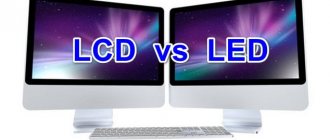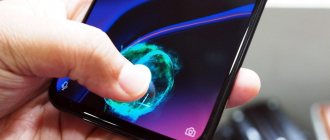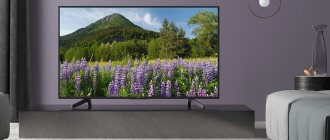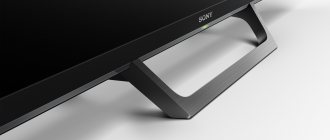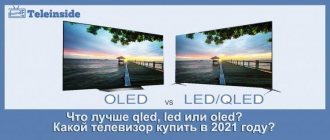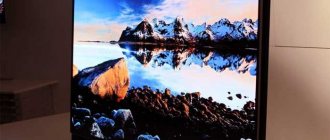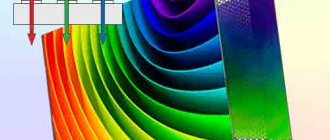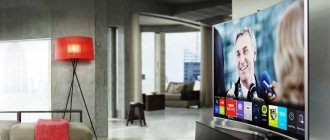When creating new TV models, manufacturers try to use the newest and most modern technologies. Not long ago, the world saw OLED TV models, which differ from IPS and other technologies in high performance and some other characteristics. This is due to the fact that such panels do not require light filters or additional lighting. Also, this feature allows such TVs to be thinner and easier to manufacture than models with IPS technology. But let's first understand what, in general, an OLED display is and how it works.
An OLED TV is a TV whose matrix is mainly composed of carbon-based organic light-emitting diodes. Such screens are often installed in players, phones and other gadgets. It’s not easy for an ordinary person to imagine such a combination, but it works like this: electrical impulses pass through organic light-emitting diodes, causing them to glow. The color that each of these diodes will glow depends on the color of the phosphor with which it is coated. As is customary, this is a red, blue or green phosphor, the combination of which allows you to obtain a huge number of other colors and shades. OLED TV has the shortest response time among all TVs, a wide viewing angle and excellent light transmission. Such screens have many advantages, but also have their disadvantages. Let's discuss all this in order.
What types of screens are there?
The structure of the main types of displays
Displays of modern electronics are constantly evolving. Cathode ray tubes became extinct and were replaced by liquid crystals and LEDs.
Today, at least 4 large classes of screens with their own manufacturing technology and image display features coexist simultaneously on the market.
TN (Twisted Nematic). The most affordable display that uses liquid crystals to create images, the image on which becomes visible thanks to backlighting from incandescent, fluorescent and other lamps. This class is obsolete, although in a number of use cases it has no analogues.
STN (Super Twisted Nematic) , as well as Double STN and DSTN (Dual-ScanTwisted Nematic). Continuation of LCD screens with improved parameters. They are sold under the name regular TN.
IPS (In-Plane Switching). A type of LCD that uses a more uniform and bright LED backlight.
VA (Vertical Alignment). Philips proprietary matrix, which combines the advantages of IPS and TN matrices. The characteristics are somewhere in between, as are the advantages and disadvantages. Not used in compact electronics.
AMOLED (Active Matrix Organic Light-Emitting Diode). Instead of a two-layer “liquid crystal + backlight” matrix, the technology uses a single layer of organic LEDs: they provide both color and light.
Viewing Angles
An important parameter when choosing a TV is its viewing angles, since the quality of viewing will directly depend on this. If a large company gathers, the image on the screen must be clear from any side, otherwise certain people will be uncomfortable watching the content.
OLED TVs have the most ideal viewing angles, so the image from any part of the room will look clear, bright and rich. Other TVs cannot boast of such quality. They may display picture distortion, glare and extraneous noise.
Interesting fact: viewing angles of OLED and QLED screens reach 170 degrees.
IPS Features You Need to Know About
Basic design of an IPS screen
IPS matrices have become so widespread due to the fact that they are really easy to produce. Among their advantages:
Availability. Mass production is doing its job, making it possible to use the TN matrix production factories of the past to create IPS.
Color rendition. Liquid crystals can display many colors, and LED perfectly complements the capabilities by accurately illuminating the current position of the pixels. In addition, the experience of engineers has made it possible to turn IPS matrices into the most accurate displays. True, so far the matter does not concern black color.
Energy consumption. Liquid crystals that form the image on an IPS screen consume almost no current. The main energy consumer is backlight diodes.
Durability. Liquid crystals are not subject to aging and wear. Backlight LEDs also have a huge resource.
Uneven illumination is clearly visible
However, IPS has many theoretical and actual disadvantages:
Black color. A TN matrix cannot have a pure black color: under the color emitter layer there is still a backlight that forms an image trail.
Low contrast. The low depth of black does not allow the shades of gray to be accurately separated; they are mixed. In addition, the backlight has a narrow luminosity range, which results in a low difference between the brightest and darkest pixels.
Great response time. In this case, the problem is entirely in the backlight: its LEDs simply do not have time to respond quickly.
Advantages of OLED technology
OLED is the most advanced technology. To appreciate its advantages, you do not need to be a technical expert, since most of the advantages are visible to any user:
- high image clarity and sharpness;
- light weight and ultra-thin screen;
- environmental friendliness - OLED devices consume a small amount of electricity, in the long term this means that their use causes less impact on the environment and electricity bills;
- the use of organic crystals, which results in a high pixel density;
- safety;
- deep black color;
- There is no separate backlight that would affect the dimensions of the TV, and due to its thinness and lightness, the device fits perfectly into the interior of even a small room.
AMOLED Features You Need to Know About
Basic design of an AMOLED screen
In turn, [A]MOLED has its own set of diseases: independent LEDs are both harmful and beneficial. So, among the advantages:
Separate pixel glow. One pixel is one LED that stays off when displaying black, providing nearly infinite contrast.
High speed. Separate pixel control helps achieve higher frame rates, which are achieved through fairly complex control circuits.
Low power consumption. Dark areas for AMOLED require less power consumption, while black areas consume nothing. Conversely, white color is extremely ruinous for them.
Uneven LED size leads to artifacts
However, existing technologies leave a number of “childhood diseases” that cannot yet be eliminated.
PWM All LEDs glow in pulses. This becomes noticeable at low display brightness. In IPS this is solved by rows of synchronous backlighting, but in AMOLED you have to look for a balance: either a bright glow with a blue tint (it is better visible to the human eye), or a low frequency of “blinking” diodes (high strain on the eyes).
White balance. Blue LEDs burn out faster due to technological features, so AMOLED screens suffer from incorrect color display (sometimes as a preventative measure).
Memory effect. A static picture causes OLEDs to lose brightness, which leads to artifacts over time.
PenTile. An attempt to solve the problem of blue LEDs led to the use of a different number of subpixels. And this is visible at low brightness.
ASUS at CES 2021
This year, CES 2021 (Computer Electronic Show) will be held online. All companies are preparing to present their new products and ASUS is no exception. Of course, I cannot talk about new products in advance, but I think that you yourself understand perfectly well which models are already a little outdated and require updating. The Zenbook Pro Duo seems the most obvious from the list above, because there is already a very similar model on the market in a similar chassis, but under the Republic of Gamers brand - this is the Zephyrus Duo 15. It takes into account the shortcomings of the Zenbook Pro Duo and the second screen rises along with the opening covers, making the viewing angle of the second screen more comfortable. But in the gaming model ROG Zephyrus Duo 15 there was no place for an OLED panel, because there are no panels with high display frequencies on the OLED screen market. By combining just these two features, there is already a clear contender for an update in the lineup. But there is also a younger version - ASUS Zenbook Duo, which also looks like a contender for an update. There is a little less than a month left before the press conference; it will take place on January 13, 2021 at 20:00 Moscow time. You can follow the countdown timer to the start of the event on the website.
How and what will we test?
For the purity of the experiment and the most correct comparison of the 2 types of screens, we will test smartphones. They are the ones who use the highest quality matrices: small displays are easier to make than huge TV panels.
The test subjects will be 2 Xiaomi smartphones: in the left corner of the ring is a Mi 8 with an AMOLED matrix, in the right is a simplified Mi 8 Lite with an IPS screen.
The belonging of devices to one manufacturer and generation gives a rough idea of the development of technologies in a cross-section.
The more affordable Mi 8 Lite is cheaper, not least thanks to the screen, but to maintain its position, the sub-flagship must be equipped with the highest quality matrix. No worse than the flagship.
Application area
OLED screens are a promising technology. Currently, they are used in mobile phones, digital video cameras, home televisions, but the most interesting application is for advertising, design and educational purposes:
- Advertising designs. High transparency and low thickness make transparent OLED screens an ideal material for making indoor advertising displays for stores and cafes.
- An interesting design solution is the use of transparent touch displays in the interior of shops, restaurants, scientific and educational centers.
- Another unique development is a mirror with a touch-sensitive transparent OLED display. Such a device can be installed in stores. It will allow customers not only to contemplate their reflection, but to save time by virtually trying on clothes. It is enough to select a model on the screen and the buyer will see his reflection in this outfit. If the touch mirror is connected to Wi-Fi, you can simultaneously find out any information of interest.
- Mirrors with touch OLED displays and flexible screens can be used for decorating hotels, shopping centers, cafes, clubs, and business centers.
- Flexible OLED displays allow you to create unique educational and exhibition aids: interactive maps of the Earth and the Starry Sky, installations and much more.
Brightness and operating features
IPS screen of Mi 8 Lite (left), AMOLED screen of Mi 8 (right)
The smartphone screens are completely identical in size and resolution, differing only in the size of the “cutout” for the front camera. This allows you to view the parameters in detail.
And we will do this not in the laboratory, but in combat conditions of complex lighting, it’s more visual and interesting. Especially when it comes to what matters most: brightness, backlight uniformity and image clarity.
Mi 8 AMOLED screen
As you can see in the photo above, even the OGS screen (without an air gap) of the Mi 8 Lite has more glare. The reason is 3 layers of the screen: protective glass, a layer of liquid crystals, backlight.
A more uniform backlight allows for greater visible color density, which looks “bolder” on the Mi 8 with AMOLED. The thing is that brightness, contrast and dynamic range are indeed higher even at similar levels.
IPS screen Mi 8 Lite
If you pay attention, the fonts on the AMOLED screen are clearer and more sharply drawn. Moreover, in cases with complex colors, dull shades.
However, background areas on the LCD display are better developed, soft transitions are brighter and more distinguishable.
Market restrictions
So why doesn't everyone know what it is? OLED TVs are prohibitively expensive, and for a very long time, only two companies, LG and Panasonic, used similar technology in their panels. Fortunately, today everything is changing. Sony, one of the first developers of such technology, returned to the game in 2021 with a new version of the Bravia A1E television signal receiver.
So what are OLED TVs? Are they worth their cost? And what are their benefits?
Artifacts that are not visible
Mi 8 AMOLED screen: Pentile
Macro shots, even at maximum brightness, reveal the shortcomings of each type of display.
The OLED matrix used by Xiaomi shows off its structure. The eye usually doesn't notice uneven pixel brightness, but the white background and the camera show the defect.
The same Pentile, which is typical for all similar screens, may or may not be visible. But one way or another, this structure is used in all mass displays.
Mi 8 Lite IPS screen: visible pixel grid
The liquid crystal matrix shows its structure in any color, at any brightness. But the pixel grid does not strain the eyes, unlike uneven brightness.
In addition, increasing the backlight frequency beyond 60 Hz practically eliminates the main drawback of the IPS panel. With AMOLED this trick is more difficult, but still irritates the eyes.
Classification
With the development of technology and increasing picture requirements, several methods have emerged to control the emitted light used to generate materials.
By control method
There are two types of control of organic light-emitting diodes: AMOLED and PMOLED - active and passive matrices, respectively. First, controllers split the matrix into columns and rows. The desired pixel lights up at the intersection of rows and columns. To form a picture, you need to perform many cycles - one pixel is illuminated per cycle. This is an inexpensive technology, relevant for displays with a diagonal of up to 3”.
PMOLED screens instantly form an image thanks to direct control of the state of each pixel. Using the technology, displays with diagonals of tens of inches (50-60 or more) are manufactured.
Combined OLED-LCD screens show a clear picture with mediocre color rendition.
By cell type
The OLED cell has a composite structure. There are single and multilayer cells, transparent and upward emitting OLED.
In a single-layer one, an emitter layer is placed between the anode - a transparent current-conducting material - and the cathode. The substrate is made of glass or polymer. In the second case, the characteristics of OLED are inferior to those created using a glass base. Single-layer LEDs are dozens of times inferior in performance to multilayer LEDs.
After placing a hole-conducting layer between the emitter and anode and an electrically conductive layer between the cathode and phosphor, the brightness of the glow increases significantly. The matrix characteristics are improved by the addition of new layers: copper phthallocyanine, for example, facilitates hole injection.
The following methods of implementing the technology are less common:
- Up-emitting or TOLED - are made on an opaque substrate with a transparent or translucent cathode.
- Transparent LEDs - emit light in both directions. They are used to create display windows and lamp screens.
- Stacked OLEDs – provide the same glow intensity of cells of any color over the entire area.
- Combination of OLED with field effect transistor.
Color: where is the right one?
Mi 8 Lite IPS screen (left), Mi 8 AMOLED screen (right), cool color scheme
With the colors of different types of screens, everything is not as smooth as it seems. It is widely believed that AMOLED has a poisonous gamma, IPS is better adjustable and offers the most accurate gamma.
In practice, everything is confirmed by the human eye and turns out to be exactly the opposite when studied through optical instruments.
Mi 8 Lite IPS screen (left), Mi 8 AMOLED screen (right), standard color scheme
It's all about the insidiousness of the protective glass coatings: the developers managed to “soften” the white on the Mi 8 AMOLED panel using an oleophobic coating.
The same anti-greasy coating on the glass of the Mi 8 Lite gives the opposite effect, seriously distorting the gamma into a cold spectrum.
This behavior occurs with any color gamut settings. What's the matter?
Mi 8 Lite IPS screen (left), Mi 8 AMOLED screen (right), warm color scheme
The screen of the Mi 8 Lite has too much glare due to the split structure, while the gamma of the Mi 8 does not need correction. The absence of layers allows the display to show what the developers intended, regardless of external conditions.
Macro photographs only confirm what has been said. Adjusted for overall brightness, the Mi 8's brightness levels are always higher.
Perspective
Today it is already obvious that OLED TVs are a technology that, even after several years of intensive development, still remains quite complex and expensive for manufacturers. The fact that it has existed for so long and has not yet reached the level of mass production makes many people think that it has no future.
It is quite obvious that companies have not yet abandoned OLED. This means the opposite. The technology is far from oblivion. But after so many years of trying to get it to work effectively, it's hard to maintain hope that it will ever become truly available.
Let's look at it from an angle
IPS screen of Mi 8 Lite: transparent colors, correct white
A more careful study at close range changes the position of the liquid crystal matrices: now AMOLED glares, IPS does not.
Only then does it become clear that there is no real difference between the white balance of screens, it all depends on external distortions and perception.
Selecting a different lens and shooting conditions will turn the situation in a different direction. Therefore, it is the structure and refresh rate that will determine the quality of color rendering.
AMOLED screen of Mi 8: rich colors, correct blacks
In this case, AMOLED will have a hard time, since increasing the shooting speed will leave the white color white for IPS, and iridescent for the organic LED matrix.
Returning to the title, it should be noted: there are no visible problems when changing the viewing angle for both types of matrices. Not surprisingly, the refresh rate and pixel density are too high.
At low resolutions, IPS will demonstrate black problems at an angle.
Rating of the best models
After analyzing user reviews, the top best TVs with OLED displays were compiled. When compiling the rating, special attention was paid to how much the device costs, what kind of screen it has and the year of manufacture. We present to your attention the 10 highest quality OLED panels today:
- LG OLED55B8SLB. Advantages: thin body and attractive appearance, quality and brightness of the matrix, high sound level, convenient remote control with many built-in functions, unique operating system. Disadvantages: high cost, mainly due to advertising.
- LG OLED55C8. Pros: powerful and modern processor, built-in image enhancement mode, thin body and high-quality build, high volume and sound levels. Cons: high price, about $2,000.
- LG OLED55B8. Positive aspects: image realism, picture clarity, body thickness, volume and sound levels, voice control support. Negative aspects: high cost.
- LG OLED55B7V. Advantages: speed, Dolby Atmos support, image clarity and brightness, body thickness, small distance between the frame and the screen. Disadvantages: for some reason the cost is too high.
- LG OLED77G7V. Pros: multifunctional operating system, thin body, large screen, high-quality sound, fast operating speed. Cons: high price, rather large distance between the wall and the TV.
- LG OLED77C9. Positive points: image quality, volume and sound levels, thickness of the case, powerful processor, ability to change the wallpaper. Negative points: heavy weight, high cost.
- LG OLED65W7V. Advantages: picture clarity, large and thin display, stylish appearance, sound quality, speed, ability to run games. Disadvantages: high price, glossy screen.
- Sony KD-55A Pros: Android TV support, high-quality screen, high brightness reserve, presence of a light sensor, attractive appearance, loud sound. Cons: high cost.
- LG 65EF950V. Positive aspects: 4K screen at an affordable price, image clarity, good brightness reserve, high-quality sound, stylish appearance. Negative aspects: glossy screen.
- Sony KD-77A1. Advantages: large display, high-quality picture, realistic color reproduction, loud sound, Disadvantages: high price.
You can also choose other models: LG OLED55C7V, LG 55EG9A7V, KD-55AF8, LG 55EG910V or Sony Bravia. All of them have a large number of positive reviews and high ratings.
Important: a thorough performance check at the time of purchase is required!
To summarize, we note that a high-quality OLED TV costs a lot of money, so when choosing it, get ready to spend at least $700-800. If things are not going well with finances, then it is better to consider a model from the line with LED screens.
Samsung C49RG90SSI 48.8″
- Display: 5120x1440 (32:9), 120 Hz
- Matrix: *VA (QLED)
- Brightness: 1000 cd/m²
- Connectors: HDMI 2.0, DisplayPort 1.4 (X2)
- Response time: 4ms
Price: from 75,000 rubles
Next up is Samsung with the C49RG90SSI model with a diagonal of as much as 48.8 inches. It uses a QLED matrix, which is being actively improved by the company. That is why most of the monitors in the selection will be from Samsung.
This monitor is a great option for gamers. An ultra-wide screen, huge display resolution and brightness, more than 1 billion colors, support for all necessary ports and FreeSync 2, a curved screen, an image refresh rate of 120 Hz - all this will allow you to enjoy your favorite games and be completely immersed in the atmosphere. An ideal choice if you don't mind that the price of this monitor is about the same as the average gaming computer.
Motion transmission
LCD TVs can suffer from blurring because they take time to transition from one color to another. OLED pixels change almost instantly. This way, when watching sports or other fast-paced action, images will be clearer and more detailed. However, OLED technology is still not ideal for conveying motion as it uses a sample-and-hold method, but it performs better than LCD.
MSI Optix MAG274QRF 27″
- Display: 2560×1440 (16:9), 165 Hz
- Matrix: IPS (QLED)
- Brightness: 300 cd/m²
- Connectors: HDMI 2.0b (X2), DisplayPort 1.4
- Response time: 1ms
Price: from 41,000 rubles
The last monitor on the list is from MSI. Optix MAG274QRF received a 27-inch diagonal, a frame refresh rate of 165 Hz, WLED backlight, HDR and many other functions. The monitor is designed for games, which is facilitated by a low response time of 1 ms, as well as support for G-Sync Compatible and FreeSync Premium technologies. In addition, the new product from MSI has a convenient multifunctional stand and a design that gamers will definitely like.
Samsung U32H850UMI 31.5″
- Display: 3840x2160 (16:9), 75 Hz
- Matrix: *VA (QLED)
- Brightness: 250 cd/m²
- Connectors: HDMI (X2), DisplayPort, Mini DisplayPort
- Response time: 4ms
Price: from 33,500 rubles
Another model from Samsung. This time it is 3-4 times cheaper and with a smaller diagonal. The monitor has a standard 16:9 screen format and 4K resolution, which, together with QLED technology, ensures good color reproduction and high picture clarity.
Suitable for any task - gaming, working with images and photographs, documents, watching movies and other content. And wide viewing angles and Flicker-Free backlighting (without flickering) will provide maximum comfort. Gamers will be pleased with the presence of FreeSync technology. The U32H850UMI is a fairly simple, high-quality and versatile monitor that will appeal to almost any user.
Samsung C24FG73FQI 23.5″
- Display: 1920x1080 (16:9), 144 Hz
- Matrix: *VA (QLED)
- Brightness: 350 cd/m²
- Connectors: HDMI (X2), DisplayPort
- Response time: 1ms
Price: from 20,500 rubles
Model C24FG73FQI is the most affordable in the Samsung line from this list. It boasts good color rendering, especially with the correct settings. Fortunately, there are many parameters here that you can customize for yourself. The 144Hz refresh rate ensures a smooth experience and will make a big impression on anyone who has previously used standard 60Hz monitors.
Thanks to the Flicker-Free backlight and good screen calibration, your eyes do not get tired even after prolonged use. There are no artifacts or “pink trail” problems when displaying the image. FreeSync support ensures smooth streaming without tearing. Perfect for gaming or long-term work with images and text, thanks to its gentleness on the eyes.
Philips 436M6VBPAB 42.51″
- Display: 3840x2160 (16:9), 80 Hz
- Matrix: MVA (QLED)
- Brightness: 1000 cd/m²
- Connectors: HDMI 2.0, DisplayPort 1.2, Mini DisplayPort
- Response time: 4ms
Price: from 36,700 rubles
A rare phenomenon in our rating is a QLED monitor not from Samsung. In penultimate place is the 436M6VBPAB model from Phillips. This is a huge 42.51-inch screen with 4K resolution and support for DisplayHDR 1000. Thanks to the type of matrix, HDR and WLED backlighting, it is possible to achieve a brightness of 1000 cd/m² and enormous dynamic contrast.
Perfect for watching movies, as the picture quality, rich colors and diagonal completely immerse you in the atmosphere. And the refresh rate of 80 Hz only pleasantly complements this picture and makes the image display even smoother than with the standard 60 Hz.
Buy

